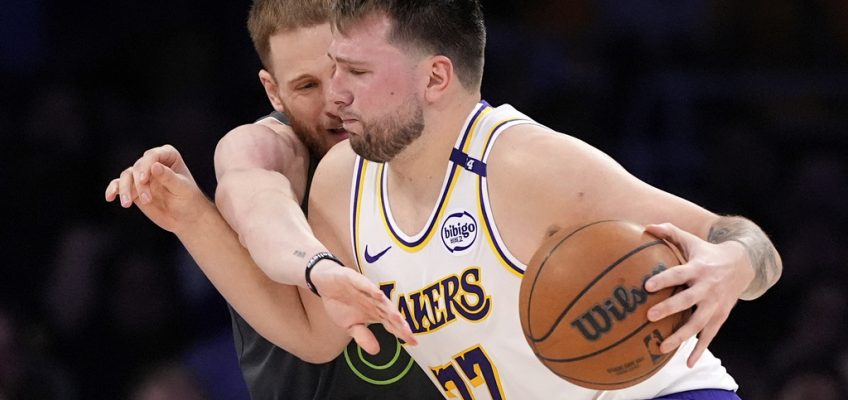Luka Doncic dominated the first quarter of Game 1 Saturday night in Los Angeles.
The Slovenian superstar scored 16 points in the frame on 10 shots, and the Lakers led 28-21 after the opening frame.
And then Los Angeles bogged down.
The Lakers shot just 38% from the field in the second quarter, while turning the ball over thrice. Minnesota out-scored the Lakers 38-20 in that quarter to take a commanding lead, and never really looked back.
Doncic finished with 37 points, but the rest of his teammates combined to shoot 34% from the field in the loss.
“Sometimes the early onslaught from Luka, it’s just easy offense and he’s getting downhill. The first possession he drives on Gobert and then he’s hitting threes. That’s really good offense for us,” Lakers coach J.J. Redick said. “And some of the other guys may not touch the ball for stretches.”
Doncic noted postgame he was trying to “set the tone.” And sometimes it works. His 20-point first quarter against the Wolves in Game 5 of last year’s Western Conference Finals was an absolute kill shot that effectively ended the series.
But there is also risk in the strategy.
A negative side effect is no one else catches a rhythm. So when it’s time for others to make plays, they aren’t necessarily in the best frame of mind to do so.
Minnesota has struggled with that same issue in recent years. There have been some first-quarter flurries from Anthony Edwards, Julius Randle and even now former-Wolf Karl-Anthony Towns that are fun in the moment. But when those individual explosions dry up over time, and if you haven’t established anything early in the game you can lean upon, it can be difficult to shift offensive gears when needed.
Minnesota, for example, is 2-6 this season in games in which Edwards takes nine-plus first quarter shots. The Wolves won 56 games last season, but again were just 5-4 in the nine games in which Edwards or Towns took nine-plus first-quarter shots.
It’s rarely an optimal approach.
Meanwhile, Edwards did take six shots in Saturday’s first frame, with minimal success. But he also had three assists in the quarter. And he took just two shots to go with two assists in the second quarter when Minnesota’s offense truly took off.
And in the second half, when everyone else around him had an established rhythm, Edwards scored 14 points. Edwards scored 22 points in Game 1 – a modest total for him – but also had nine assists and eight rebounds.
“I always say the best version of Ant is one that’s flirting with a triple double,” Timberwolves coach Chris Finch said. “Got his teammates involved, I thought, with even more timely passing.”
That’s certainly not to say Minnesota doesn’t want its best player to shoot. Far from it. But in today’s NBA, with the ways defenses have evolved to make life as difficult as possible on the star players, you truly need everyone to crack the defensive codes.
The balance for every star and team to strike is to determine when it’s necessary to move the ball around and play good pace and space offense, and when you may need to rely on your star(s) to hit a tough shot.
Minnesota turned to the latter in the fourth quarter. When the Lakers were mounting a comeback charge and had pulled to within 13 points, Randle and Edwards both stemmed the tide with contested mid-range jumpers. Then Edwards hit a tough triple over Doncic’s out-stretched arms.
That the successful shotmaking stretch came after two quarters of really good team basketball seemed like no coincidence.
All season, Wolves wing Donte DiVincenzo has preached the power of having both options at the team’s disposal.
“It also builds confidence in everybody that those guys are very unselfish and when a defense throws whatever they’re throwing, they’ll find the open shooter, the open cutter and make plays for everyone else,” DiVincenzo said. “And also we rely on them when things are not in rhythm for us to go get a bucket, calm us down and be themselves.”
Mike Conley said the Wolves have “done a great job” striking the balance.
“Hats off to Ant and Julius being able to be unselfish enough to allow us for the first three, three and a half quarters to play a certain way (and) get off the ball,” Conley said. “And then they know in the fourth quarter, late in the game, it’s your show. Shoot every shot. Shoot the mid range, shoot the fadeaways. All those are shots they shoot every day. They just try not to do that too early in games and be stagnant. That has been our battle all year.”
Related Articles
Timberwolves no longer underdogs against Lakers. Is that cause for concern?
Timberwolves Playoffs: Reserves again ignite team’s best play
The Timberwolves had one of best shooting performances of the season Saturday. How will the Lakers react in Game 2?
Pack of rabid Timberwolves harass Lakers en route to Game 1 rout
Timberwolves playoffs: From contracts to reputation, what’s at stake


Leave a Reply